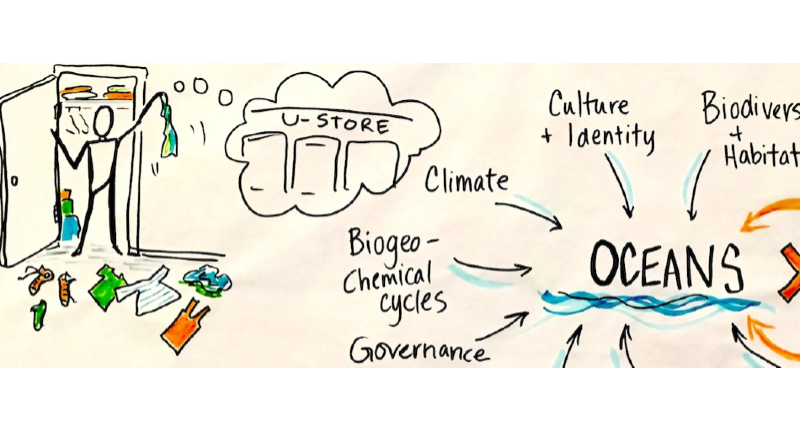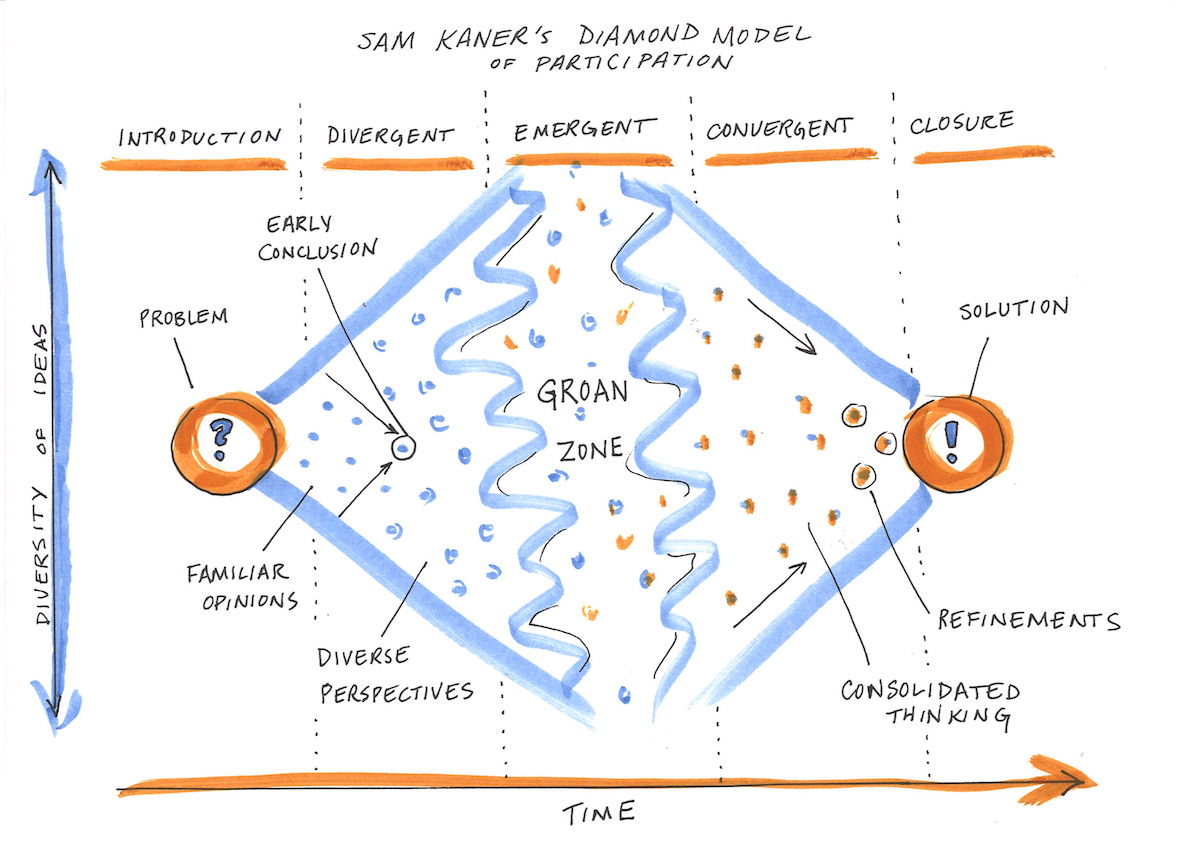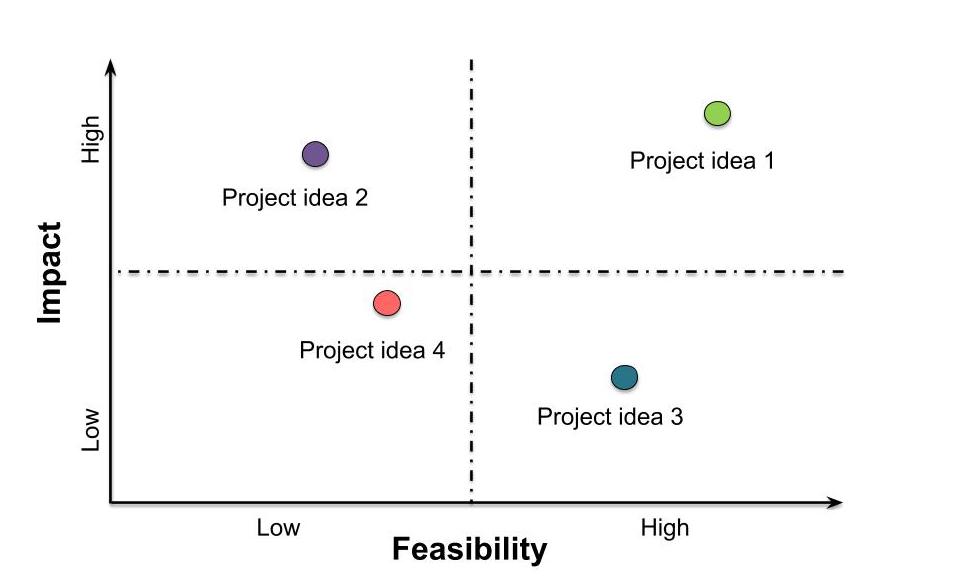How to Spark Joy in the Groan Zone of Collaboration

A version of this commentary has been cross-published here, on the Integration and Implementation Insights (i2Insights) blog. It is part of our commentary series on collaboration.
As researchers and practitioners engaged in transdisciplinary problem-solving, we know the value of diverse perspectives. We also know how common it is for groups to run into challenges when trying to learn from diverse ideas and come to consensus on creative solutions.
This challenging, often uncomfortable space is called the Groan Zone, and the term comes from Sam Kaner’s Diamond Participation model, shown in the figure below. After an initial period of divergent thinking, where diverse ideas are introduced, groups have to organize that information, focus on what’s most important, and make decisions in order to move forward into the phase of convergent thinking.
Navigating that transition between divergent and convergent thinking is the realm in which creativity and innovation emerge, if we let them.

Adaptation of Kaner's Diamond Model of Participation, as found in his book 'Facilitator's Guide to Participatory Decision Making.' Credit: Carrie Kappel.
My own, recent experience navigating the groan zone happened midway through a two-day workshop I was facilitating on oceans and the future of food, where an interdisciplinary, multi-sector group of participants became daunted by the task of integrating their extensive set of ideas and perspectives into a shared research agenda. Emotions in the room ran from optimism to incredulity to near panic.
One of the organizers, Dr. Liz Selig of Stanford Center for Ocean Solutions, remarked, “We're at that stage when we have taken everything out of the closet and it’s all strewn across the floor. Now we have to sort through it all and start to make sense of what’s important, what to keep, how to organize it so we can find what we need.”
Every interdisciplinary working group I’ve ever participated in or facilitated has found themselves in the Groan Zone, staring overwhelmed at that metaphorical messy floor. The good news is you don’t have to be a skilled facilitator to employ the tools for navigating this territory and tapping its creative potential. Here are some tips:
1. Don’t Panic
Half the battle is recognizing that you are entering the Groan Zone. Just naming the transition from divergence to convergence as a distinct, valuable, and normal phase can help to reassure a group.
2. Encourage Dialogue
Dialogue, rather than debate, allows collective insight and creative breakthroughs to emerge in groups. Challenge participants to speak to be understood, rather than to win a point, and listen for understanding, rather than for the weakness in another’s argument. Put a premium on defining terms, unpacking assumptions, and explaining thinking to bridge diverse disciplinary perspectives. When participants interact in this way, they tend to feel more comfortable wading into the Groan Zone’s uncertainty and trusting the process – and each other – to carry them through to the other side.
3. Use Tools to Support Convergence
Build in specific processes to converge on ideas. It’s not exactly a process of Marie Kondo’ing all those ideas you pulled out of your intellectual closets, asking if they bring you joy, but more like seeking that collective intellectual tingle that comes from lighting upon an idea that has the potential to unlock new insights.
There are also countless tools for sifting and synthesizing ideas, such as these that I’ve found useful:
- Use conceptual frameworks to organize ideas and draw connections. Constructing a visual model together helps to reveal the different ways individuals think about the problem, which can build a shared understanding of it and unlock new ways of addressing it. Joint model building supports metacognition, raising awareness of individual assumptions, gaps, and biases.
- Take a staged approach to prioritizing ideas. Invite individuals to reflect on their own, then share in pairs, then bring their insights and ideas to another pair or small group, and finally offer highlights to the full group. This 1-2-4-all process offers everyone a chance to speak and allows the group to elevate the most promising ideas rapidly.
- Get the ideas on paper. Give each idea a headline, and write a short abstract that distills the problem, why it’s important, and your proposed solution. Review each other’s ideas. Identify areas of confusion or uncertainty. Clarify.
- Specify your criteria for convergence. A simple two-axis plot can help a group decide how to focus its effort. For example, as shown in the figure below, you might assess each idea for its feasibility and potential impact, and then focus on those scoring high in both. Defining what you mean by feasibility and impact before your start scoring is essential and can be another source of collaborative learning.

Inviting diverse perspectives (divergence), synthesizing to yield new breakthroughs (emergence), and coalescing around a shared vision (convergence) are fundamental elements of successful collaboration, and they don’t just happen once. In fact, a well-designed collaboration will move through these stages over and over again.
In the arc of a project, a group may encounter the groan zone at multiple scales – within an individual discussion, midway through a multi-day meeting, part way through a multi-year project, or all of the above. A recent survey of NCEAS working group participants showed that their satisfaction ebbs in the messy middle of their projects, but rises again as the project approaches the end.
Recognizing that the groan zone is inevitable, our best option is to embrace it and let it spark opportunities for the emergence of novel ideas. Armed with awareness and a few good process tools, could we come to see the groan zone as an essential growth zone instead?
# # #
Carrie Kappel is a Senior Fellow, research scientist and professional facilitator of transdisciplinary collaborative working groups at NCEAS.
